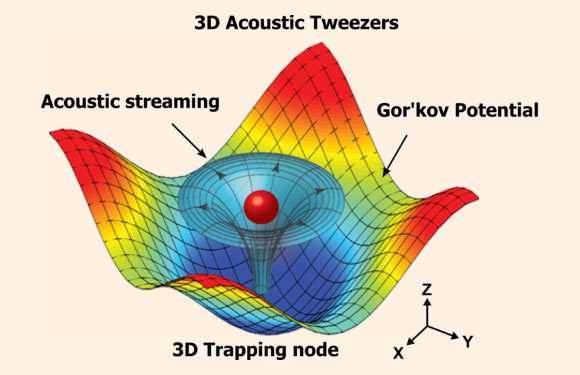A team of scientists from the United States has demonstrated that ‘acoustic tweezers’ can be used to trap and manipulate single cells along three dimensions without touching, providing a promising new method for 3D bioprinting.

Numerical simulation results mapping the acoustic field around a particle that shows the physical operating principle for the 3D acoustic tweezers. 3D trapping node in the microfluidic chamber is created by two superimposed, orthogonal, standing surface acoustic waves and the induced acoustic streaming. Image credit: Tony Jun Huang / Pennsylvania State University.
The results were published online this week in the Proceedings of the National Academy of Sciences.
“The results provide a unique pathway to manipulate biological cells, accurately and in three dimensions, without the need for any invasive contact, tagging, or biochemical labeling,” said team member Dr Subra Suresh, of Carnegie Mellon University.
“This approach could lead to new possibilities for research and applications in such areas as regenerative medicine, neuroscience, tissue engineering, biomanufacturing, and cancer metastasis.”
Dr Suresh and his colleagues from the Pennsylvania State University, Massachusetts Institute of Technology, and Carnegie Mellon University, have been at the forefront of developing acoustic tweezers technology, a technique that uses sound waves to trap and manipulate single cells.
Acoustic tweezers have been used to separate, align, pattern and transport single cells, and are renowned for their ability to gently manipulate cells without causing any cellular damage.
In order to make the technology functional for 3D printing, the scientists needed to prove that it could capture and manipulate cells along all three dimensions.
Their current version of acoustic tweezers involves a microfluidic device that uses acoustic wave generators to produce sound waves along the edges of the device.
The device’s design allowed the team to manipulate where the waves would meet along each of the three axes. At these meeting points, the waves formed a 3D trapping node that captured individual cells. They could then further manipulate the acoustic waves to move and place cells.
“We present 3D acoustic tweezers, which can trap and manipulate single cells and particles along three mutually orthogonal axes of motion by recourse to surface acoustic waves,” the researchers said.
“We use 3D acoustic tweezers to pick up single cells, or entire cell assemblies, and deliver them to desired locations to create 2D and 3D cell patterns, or print the cells into complex shapes.”
“This technology is thus shown to offer better performance over prior cell manipulation techniques in terms of both accurate and precise motion in a noninvasive, label-free, and contactless manner,” they added.
Their device can place a cell or particle with 1 micrometer accuracy horizontally and with 2 micrometer accuracy vertically.
They moved a 10 micrometer particle at an average speed of about 2.5 micrometers per second and could place cells in several seconds to a few minutes depending on the distance.
“Because the acoustic wavelength and input power are instantaneously tunable during experiments, the placement accuracy is only limited by the resolution of the device setup,” Dr Suresh and co-authors said.
_____
Feng Guo et al. Three-dimensional manipulation of single cells using surface acoustic waves. PNAS, published online January 25, 2016; doi: 10.1073/pnas.1524813113







